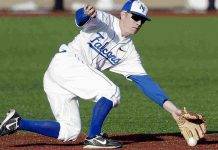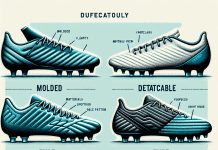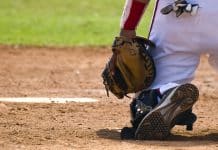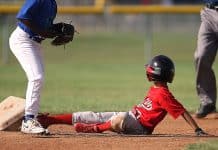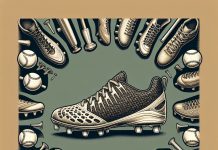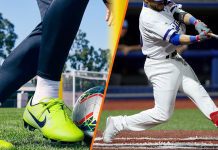In the realm of baseball, the age-old question remains: are high or low cleats better for the game? Whether you’re a seasoned player or just starting out, the choice of footwear can greatly impact your performance on the field. With high cleats providing ankle support and stability, and low cleats offering increased mobility and agility, it’s crucial to understand the pros and cons of each option. So, lace up your cleats and join us as we navigate the world of baseball footwear to determine which style reigns supreme.
Traction
Review contents
Material and Design
When it comes to baseball cleats, traction is a crucial factor to consider. The material and design of the cleats play a significant role in determining the traction they provide on the field. High-quality cleats are usually made from durable materials like synthetic leather or a combination of synthetic and genuine leather. These materials offer good grip and prevent slipping or sliding while running or making quick turns on the field.
The design of the cleats also contributes to their traction. Cleats with strategically placed studs or spikes, particularly in the forefoot and heel areas, provide better traction on different field surfaces. The shape and length of the studs or spikes are designed to dig into the ground and provide stability, especially when running or changing directions. When choosing cleats, look for ones that have a well-thought-out material and design combination for optimal traction.
Field Conditions
The field conditions directly affect the performance of your cleats. Different fields have different levels of hardness and texture, which can impact how your cleats grip the ground. For example, cleats with longer studs or spikes are better suited for soft, muddy, or wet fields as they provide more traction and prevent slippage. On the other hand, shorter studs or spikes are more suitable for dry or firm fields, as they offer a balance between grip and maneuverability.
You should also consider the type of field you primarily play on. If you often play on grass fields, cleats with detachable studs may be a good choice as they can be adjusted based on the field conditions. However, if you mainly play on artificial turf, molded cleats with shorter studs or spikes are recommended to prevent damage to the turf surface.
Effect on Performance
Traction is directly linked to your performance on the baseball field. With good traction, you can achieve better acceleration, agility, and stability, allowing you to make quick turns, steal bases, or chase down fly balls with ease. Improved traction also helps you achieve better balance and reduces the risk of slipping or falling during high-intensity plays.
On the other hand, poor traction can significantly hinder your performance. It can lead to delayed movements, loss of balance, and reduced speed. This not only affects your ability to make timely plays but also increases the risk of injuries. Therefore, investing in cleats that provide excellent traction is essential for maximizing your performance and minimizing the chances of mishaps on the field.
Ankle Support
Preventing Injuries
Ankle injuries are common in baseball, and proper ankle support can be crucial in preventing them. High-top cleats, which extend above the ankle, provide added stability and support to the ankle joint. They help to reduce the risk of ankle sprains or twists by limiting excessive movement and preventing the ankle from rolling over during abrupt changes in direction or uneven terrain.
Low-top cleats, on the other hand, offer more mobility and flexibility to the ankle, allowing for greater freedom of movement. However, they may not provide the same level of stability and support as high-top cleats. For players who have a history of ankle injuries or are more prone to them, high-top cleats are often recommended.
It is important to note that ankle support is not the sole factor in injury prevention. Strengthening exercises, proper warm-up routines, and maintaining overall fitness are equally important in reducing the risk of ankle injuries.
Agility and Speed
While ankle support is essential for injury prevention, it can sometimes restrict agility and speed on the field. High-top cleats, due to their higher construction, may limit the ankle’s range of motion and make quick movements more challenging. If you prioritize agility and speed in your gameplay, low-top cleats might be a better choice as they allow for unrestricted ankle movement.
Agility and speed are crucial in baseball, especially for positions like outfielders who need to cover a vast area or base stealers who rely on quick bursts of speed. Low-top cleats offer increased flexibility, allowing players to perform quick direction changes, accelerations, and decelerations more efficiently.
Ultimately, the choice between high or low cleats depends on personal preference and the factors that matter most to you – ankle support or agility and speed. It is important to find the right balance that suits your playing style and individual needs.
Comfort
Fit and Cushioning
Comfort is a significant factor to consider when selecting baseball cleats. A proper fit ensures that your feet are secure and supported, reducing the risk of blisters, discomfort, or injuries. Cleats that are too tight can cause pain, while those that are too loose may lead to instability and lack of control.
When trying on cleats, make sure to leave enough room for your toes to move and flex comfortably. Your heel should be snugly held in place, preventing unnecessary sliding. Look for cleats with cushioning or padding in the midsole and the collar area, as they provide additional comfort and help absorb impact during running or jumping.
Breathability
Baseball games can get intense, and your feet are likely to sweat. Choosing cleats with proper ventilation and breathability can help keep your feet dry and comfortable throughout the game. Cleats with mesh panels or perforations allow air to circulate, preventing excessive moisture buildup and reducing the chances of odor or fungal infections.
Breathable cleats are particularly important on hot or humid days when sweat production increases. They promote better temperature regulation and help maintain a pleasant playing experience.
Breaking-in Period
New cleats often require a breaking-in period to mold to your feet and become more comfortable. During this period, the materials of the cleats soften and adapt to the shape of your feet, reducing the chances of blisters or discomfort. It is recommended to gradually break in your cleats by wearing them for short periods initially and gradually increasing the duration.
Some cleats may have a shorter breaking-in period due to their design or materials, while others may require more time. It is essential to consider this factor and choose cleats that offer a comfortable fit both during and after the breaking-in period.
Durability
Quality of Materials
Durability is an important factor to consider when investing in baseball cleats. The quality of materials used in the construction of cleats directly impacts their longevity. Cleats made from high-quality materials like synthetic leather or a combination of synthetic and genuine leather tend to be more durable and resistant to wear and tear.
Consider the stitching and overall construction of the cleats as well. Reinforced stitching and solid construction contribute to the overall durability and longevity of the cleats. By choosing cleats made from durable materials and with solid construction, you can ensure that they will withstand the demands of the baseball field and last for multiple seasons.
Maintenance
Proper maintenance and care can significantly extend the lifespan of your baseball cleats. After each game or practice session, it is important to remove any dirt or debris from the cleats. Use a brush or a damp cloth to clean them thoroughly and ensure that they are free from any moisture before storing them.
Avoid leaving your cleats in extreme heat or direct sunlight, as it can cause damage to the materials. When not in use, store your cleats in a cool, dry place to maintain their integrity. Regular inspections and addressing any signs of wear or damage promptly can also help prolong the life of your cleats.
Taking care of your cleats and following manufacturer-recommended maintenance guidelines will ensure that they remain in good condition and serve you well throughout their lifespan.
Position-Specific Considerations
Infielders
Infielders require quick and precise movements, often involving rapid changes in direction. Cleats that provide excellent traction on dirt or grass surfaces are ideal for infielders. The studs or spikes should be strategically placed to allow quick pivoting and provide stability during throws or fielding ground balls.
Additionally, infielders may benefit from cleats with reinforced toe caps to protect against potential impacts from hard-hit balls. Cleats that offer good ankle support also contribute to the overall stability and confidence of infielders when making sudden movements on the field.
Outfielders
Outfielders cover a large area, often requiring them to make quick sprints and chase after fly balls. Cleats with good traction on various surfaces, including grass and dirt, are essential for outfielders. They need to be able to accelerate quickly and maintain balance while making catches or throwing the ball back to the infield.
In terms of ankle support, outfielders may opt for either high-top or low-top cleats, depending on their personal preference and the trade-off between ankle stability and agility. Ultimately, outfielders should focus on cleats that provide excellent traction, comfort, and mobility to excel in their position.
Pitchers
Pitchers play a critical role in the game, and their performance greatly relies on their ability to maintain stability and generate power during their delivery. Cleats with a balanced combination of traction, ankle support, and comfort are ideal for pitchers. They should prioritize cleats that provide a secure footing on the pitching mound, allowing them to push off efficiently and transfer power through their delivery.
Pitchers may consider both high-top and low-top cleats, depending on their personal preferences and comfort level. It is important to find cleats that offer a good balance of ankle support and freedom of movement to aid in pitching mechanics and reduce the risk of injuries.
Personal Preference
Player’s Comfort Level
Personal comfort should not be underestimated when selecting baseball cleats. Every player is unique, and what may be comfortable for one player may not be for another. It’s important to try on different cleat styles and brands to find the pair that feels most comfortable for you.
Consider the width and shape of the cleats, as well as any specific features that enhance your comfort. Some players may prefer a wider toe box, while others may prefer a snug fit. It is important to listen to your body and choose cleats that allow you to move freely and comfortably during the game.
Past Experience
Reflecting on past experiences with different types of cleats can provide valuable insight when making a new purchase. Consider what has worked well for you in the past and what aspects of previous cleats you would like to improve upon. If a particular style or brand has served you well and met your performance and comfort needs, it may be worth considering similar options for your next pair of cleats.
Player reviews and recommendations can also be a helpful resource in understanding the performance and comfort of various cleats. However, always remember that personal preferences and individual playing styles vary, so what works for someone else may not work for you.
Surface Type
Grass
Grass fields are the most common surface for baseball games. Cleats designed specifically for grass fields often have longer studs or spikes to penetrate the soft ground and provide stability. Molded cleats with a combination of conical and bladed studs are commonly used on grass fields, as they offer a balance between traction and maneuverability.
Additionally, cleats with detachable studs can be beneficial on grass fields. By adjusting the length and configuration of the studs, you can optimize traction based on the field conditions and your personal preferences.
Artificial Turf
Artificial turf fields have become increasingly popular in baseball. These fields offer a different playing experience compared to natural grass. Cleats designed for artificial turf typically have shorter and more numerous studs or nubs that provide traction without damaging the turf surface.
Molded cleats or turf shoes are commonly used on artificial turf. They offer excellent grip and allow players to make quick movements without the risk of slipping or getting caught in the turf.
Before purchasing cleats, consider the type of field you will primarily be playing on to ensure that you choose the appropriate cleat type for optimal performance and longevity.
Cost
Affordability
Cost is a significant factor to consider when buying baseball cleats. The price of cleats can vary significantly based on the brand, materials, and design features. It is important to set a budget and find cleats that offer the best value for your money.
While it may be tempting to opt for cheaper options, it’s essential to balance cost with quality and performance. Investing in high-quality cleats may initially seem more expensive, but they are likely to provide better durability and performance over time, making them a more cost-effective choice in the long run.
Long-term Investment
Consider your level of dedication to the sport and how frequently you play when deciding how much to invest in baseball cleats. If you are a casual player or play infrequently, spending a significant amount on cleats may not be necessary. However, if you are a serious player or play regularly, investing in high-quality cleats that can withstand the demands of frequent use may be a wise long-term investment.
Remember that durability, comfort, and performance should be prioritized over cost alone. Finding the right balance between affordability and quality will ensure that you make a worthwhile investment in your baseball cleats.
Availability
Popular Brands
The market for baseball cleats is vast, with numerous brands offering a wide range of options. Some popular and reputable brands in the baseball cleats industry include Nike, Adidas, Under Armour, New Balance, and Mizuno, among others. These brands are known for their commitment to quality, innovation, and performance.
Popularity often corresponds with availability, as more popular brands tend to have a wider range of styles and sizes readily available in stores and online. Considering popular brands can offer a greater variety of choices and increase the likelihood of finding cleats that meet your preferences and requirements.
Local Store Options
Local sports stores and specialty outlets are great places to explore different cleat options, particularly if you prefer to try them on before making a purchase. These stores often carry a variety of brands and styles, allowing you to compare and find the cleats that best fit your feet and playing style.
Additionally, knowledgeable staff at these stores can provide valuable advice and recommendations based on your specific needs. They may also have insights into any current deals or promotions, which can help you find quality cleats at a more affordable price.
Manufacturer’s Recommendations
Design Intentions
When selecting baseball cleats, it is important to consider the manufacturer’s design intentions. Each brand has its unique approach and design philosophy, which may influence aspects like traction, comfort, or specialty features.
Researching the manufacturer’s recommendations and understanding their design intentions can provide insight into the intended use and performance of the cleats. For example, some brands may prioritize speed and agility, while others may prioritize maximum traction or ankle support.
By aligning your needs and preferences with the manufacturer’s design intentions, you can make an informed decision about which cleats are best suited for your playing style and position.
Product Specifications
Product specifications provided by the manufacturer offer valuable information about the features and qualities of the cleats. Pay attention to details like the material used, stud or spike configuration, cushioning technology, and any specialized features.
Product specifications can help you determine if the cleats meet the requirements you are looking for in terms of traction, comfort, durability, ankle support, and other factors. Understanding the specifications can make it easier to compare different cleats and select the ones that best suit your needs.
In conclusion, choosing the right baseball cleats involves considering multiple factors such as traction, ankle support, comfort, durability, playing position, personal preference, surface type, cost, availability, and the manufacturer’s recommendations. By carefully evaluating these factors and finding a balance that suits your individual needs, you can find the perfect pair of cleats to enhance your performance and enjoyment on the baseball field. Remember, the right cleats can make a significant difference in your game, so take the time to research and make an informed decision.




